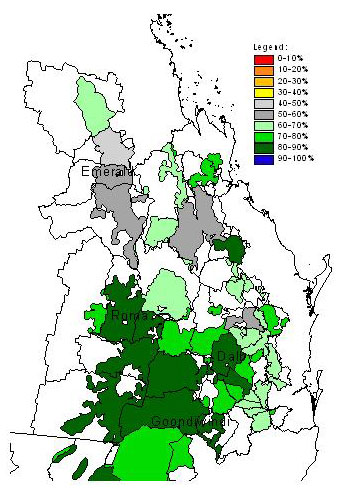Toowoomba, Queensland
May 10, 2004
The first wheat crop seasonal
outlook report from the
Department of Primary Industries and Fisheries (DPI&F) this
year has encouraging news for Queensland wheat growers.
DPI&F crop modeller Andries Potgieter said the report showed the
chances of Queensland wheat growers harvesting above-median
yields for the 2004 season were slightly better than normal at
this stage.
Mr Potgieter said the wheat outlook was less promising in
southern New South Wales, Victoria, South Australia and
inland Western Australia where the chances of exceeding
long-term median yields were lower, only 10 to 20 per cent
in some areas.
He said the forecasts were based on the outputs of a simple
agro-climatic computer model that considered El Nino and
Southern Oscillation forecasts and up to 102 years of
historical climate information to generate a crop water
stress value at shire level.
Some of the modelling information would change during the
wheat season and the forecasts would be revised each month.
Mr Potgieter said soil water profiles were a key to
Queensland's better wheat crop prospects. In southern
Queensland, rain through the summer fallow had recharged
soil water profiles to near full while water profiles were
less favourable in much of Central Queensland.
Most of the Central Highlands had a near normal chance (40
to 60 per cent) of exceeding the long-term median wheat
yield, with southern Queensland wheat areas showing a
slightly better chance (60-80 per cent) of exceeding that
median.
Mr Potgieter said there had been a few early plantings of
wheat in southern and Central Queensland but the main
planting was expected within about six weeks. Planting rain
was needed in both areas.
It was possible an El Nino event would develop in late
winter so farmers and other business operators should
consider this when making long-term management decisions and
watch for fluctuations in the Southern Oscillation Index.
Mr Potgieter said this was the
fifth wheat season for which the forecasts had been
produced. For the first time, he provided a similar
forecasting service for grain sorghum last summer. |
 |
|
The colours show the potential
for exceeding the long-term median wheat yield in the
Queensland wheat belt for the 2004 season. Yield prospects
at this stage are slightly better in southern Queensland
than in Central Queensland. |
He said agri-businesses,
governments, the Australian Bureau of Agricultural Resource
Economics and business news organisations used the wheat and
grain sorghum forecasts. |